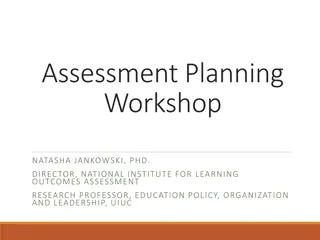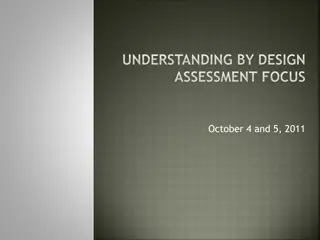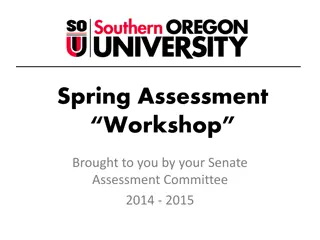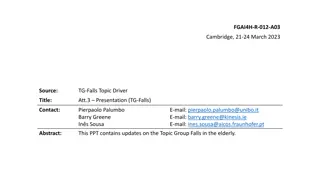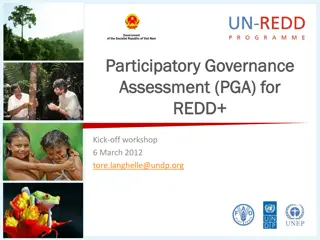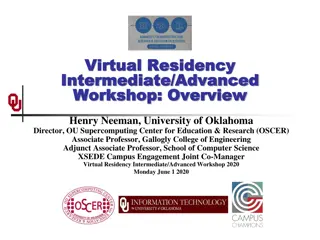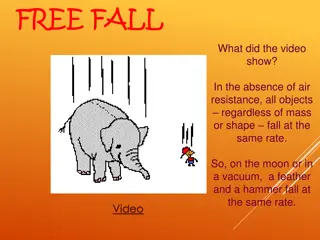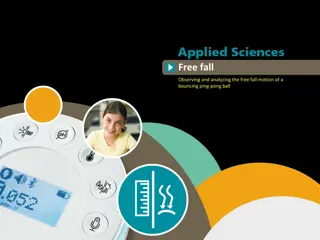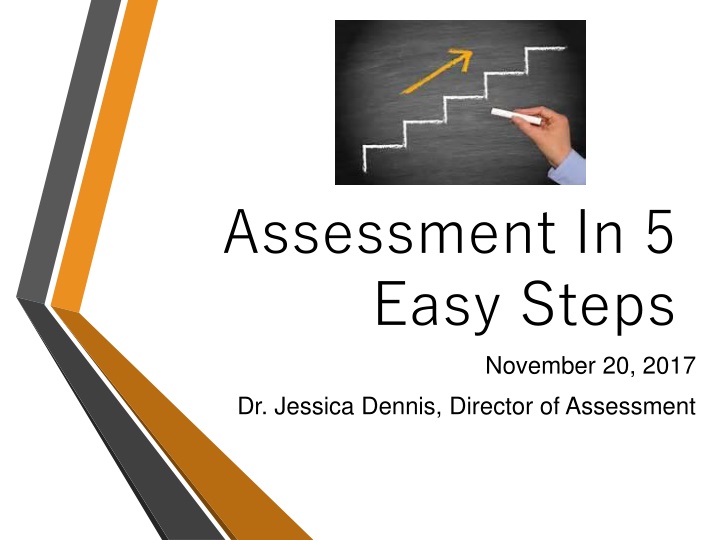
Effective Assessment Strategies for Program Improvement
Explore the essentials of assessment in education in this comprehensive guide. Learn how to implement a successful assessment cycle, differentiate between various assessment measures, collect and analyze data, and close the feedback loop for continuous improvement. Discover why assessment is crucial for student success, curriculum development, and program accreditation. Gain insights into choosing priority learning outcomes, meaningful assessment practices, and aligning assessment with strategic planning priorities.
Download Presentation

Please find below an Image/Link to download the presentation.
The content on the website is provided AS IS for your information and personal use only. It may not be sold, licensed, or shared on other websites without obtaining consent from the author. If you encounter any issues during the download, it is possible that the publisher has removed the file from their server.
You are allowed to download the files provided on this website for personal or commercial use, subject to the condition that they are used lawfully. All files are the property of their respective owners.
The content on the website is provided AS IS for your information and personal use only. It may not be sold, licensed, or shared on other websites without obtaining consent from the author.
E N D
Presentation Transcript
Assessment In 5 Easy Steps November 20, 2017 Dr. Jessica Dennis, Director of Assessment
Workshop Learning Goals By the end of this workshop participants will be able to: Describe the stages of the assessment cycle. Differentiate between indirect and direct assessment measures. Locate existing sources of data to inform program improvement. Formulate a program assessment plan.
Assessment in 5 Easy Steps 1. Pick a PLO (Program Learning Outcome) that is a priority. 2. Examine existing data. Data from Institutional Research University assessment results (info literacy, oral comm) 3. Formulate a plan to collect more useful data. Capitalize on assessments faculty already use 4. Collect and analyze data. 5. Discuss and close the loop.
The Assessment Cycle
Why is assessment important? Improve student learning and success Data-driven culture of evidence instead of anecdotes and opinions Inform curriculum revision Communicate the value of our program to our students and the public Program review and WASC Accreditation
Step 1: Choosing a Priority Learning Outcome
What is Meaningful Assessment? Should be intentional and purposive Backward design means beginning with the end in mind, anticipating the use of evidence Articulate questions important for the program: Are there disparities in academic performance among various ethnicities in our program? Are students able to transfer knowledge between our courses? Do students improve their cultural competence skills as a result of our program?
How should we decide what is meaningful? Consider strategic planning priorities Collect data to address salient issues faculty have observed To following best practices- assess each PLO on a 5-year cycle
Institutional Learning Outcomes at Cal State LA Knowledge: Mastery of content and processes of inquiry CSULA graduates have a strong knowledge base in their academic major and can use powerful processes of inquiry in a range of disciplines. They engage contemporary and enduring questions with an understanding of the complexities of human cultures and the physical and natural world and are ready to put their knowledge into action to address contemporary issues. Proficiency: Intellectual skills CSULA graduates are equipped to actively participate in democratic society. They are critical thinkers who make use of quantitative and qualitative reasoning. They have the ability to find, use, evaluate and process information in order to engage in complex decision-making. They read critically, speak and write clearly and thoughtfully and communicate effectively. Place and Community: Urban and global mission CSULA graduates are engaged individuals who have contributed to the multi-lingual and multiethnic communities that constitute Los Angeles and the world of the future. They are aware of how their actions impact society and the environment, and they strive to make socially responsible decisions. They are community builders sensitive to the needs of diverse individuals and groups and committed to renewing the communities in which they live. Transformation: Integrative learning CSULA graduates integrate academic learning with life. They engage in community, professional, creative, research and scholarly projects that lead to changes in their sense of self and understanding of their worlds. Graduates integrate their knowledge, skills and experience to address complex and contemporary issues and act ethically as leaders for the 21st century.
The Big Five Core Competencies as Defined by WASC Critical thinking the ability to think in a way that is clear, reasoned, reflective, informed by evidence, and aimed at deciding what to believe or do. Dispositions supporting critical thinking include open- mindedness and motivation to seek the truth. Quantitative Reasoning the ability to apply mathematical concepts to the interpretation and analysis of quantitative information in order to solve a wide range of problems, from those arising in pure and applied research to everyday issues and questions. It may include such dimensions as ability to apply math skills, judge reasonableness, communicate quantitative information, and recognize the limits of mathematical or statistical methods.
The Big Five Core Competencies as Defined by WASC Oral Communication communication by means of spoken language for informational, persuasive, and expressive purposes. In addition to speech, oral communication may employ visual aids, body language, intonation, and other non-verbal elements to support the conveyance of meaning and connection with the audience. Oral communication may include speeches, presentations, discussions, dialogue, and other forms of interpersonal communication, either delivered face to face or mediated technologically. Written Communication Communication by means of written language for informational, persuasive, and expressive purposes. Written communication may appear in many forms or genres. Successful written communication depends of mastery of conventions, faculty with culturally accepted structures for presentation and argument, awareness of audience and other situation-specific factors.
The Big Five Core Competencies as Defined by WASC Information Literacy according the Association of College and Research Libraries, the ability to recognize when information is needed and have the ability to locate, evaluate, and use the needed information for a wide range of purposes. An information-literate individual is able to determine the extent of information needed, access it, evaluate it and its sources, use the information effectively, and do so ethically and legally.
Activity #1: Pick a Priority Which PLOs are your department s strengths? Which are your weaknesses? What is one question you would most like to answer with regard to your PLOs?
Step 2: Examine Existing Data Sources
Indirect Methods of Assessment Graduation or Completion Rates Placement Rates Student Survey Student Interviews or Focus Groups Alumni Survey Employer Survey Faculty Survey Exit (end of program) Survey or Interviews Reflection Essays Diaries or Journals Data from Institutional Surveys (NSSE) Curriculum/Syllabus Analysis Checklists
Existing Data Sources from Institutional Research (IR) See IR data pull reference sheet Interactive reports of enrollment trends and graduation rates by gender and ethnicity Admission and course data, including bottleneck course analysis
Surveys Regularly Administered by IR Entering Freshman and Entering Transfer Survey Collected every year on admissions process, high school experiences, view of self, finances, expectations of time at Cal State LA, degree attainment goals Senior Survey Collected in 2013 and 2015 on time-to-degree, perceptions of faculty, campus community, skill development, time allocation, plans after graduation, different areas of satisfaction Baccalaureate Alumni Survey Conducted in 2015 targeting recent graduates, early career, and mid-career, regarding undergraduate education experience, current activity/employment, career, pursuit of additional education, education-related debt National Survey of Student Engagement (NSSE) Administered in 2014, 2017 with freshmen and graduating seniors focused on student engagement (academic challenge, learning with peers, experiences with faculty, campus environment) and advisement
Recent Data Collected by Assessment Team to Examine Institutional Learning Outcomes Informed by the Educational Effectiveness and Assessment Council (EEAC) Results available from Jessica Dennis Information Literacy (2017)- Standardized Assessment of Information Literacy Skills (SAILS) test given to sample of freshmen and seniors 35 Business, 20 Engineering/Computer Science, 17 Science/Math, 32 Social Science/Psychology, 42 Other (Education, Law, Performing Arts, etc.) Oral Communication (2017)- Seniors presentations in capstone courses were videotaped and scored with a rubric A&L (COMM 4300, COMM 4390), B&E (BUS 4150, BUS4970), CCOE (COUN 4940A), HHS (COMD 3190, KIN4250), NSS (ANTH 4970, CHEM4311, PSY 3040).
Activity #2: Existing Data Make note of any IR or Assessment Team data source that could inform your program and answer key questions you have. What is the data source? What question can it answer?
Oral Communication Scores: Psychology (n = 23) Proficiency Score Organization Language Delivery Supporting Material Central Message 3.75-4.0 0 (0%) 3 (13%) 1 (4%) 2 (9%) 1 (4%) 3.0-3.5 15 (65%) 14 (61%) 10 (44%) 15 (65%) 18 (78%) 2.0-2.75 8 (35%) 6 (26%) 9 (39%) 6 (26%) 4 (17%) 1.0-1.75 0 (0%) 0 (0%) 3 (13%) 0 (0%) 0 (0%) Note. Scoring was as follows: 1 = Benchmark (Does not Meet Competency), 2 = Milestone (Minimal Competency), 3 = Milestone (Meets Competency), 4 = Capstone (Exceeds Competency). What trends do you notice? What questions are left unanswered? How could we collect more useful data?
Step 3: Formulate a Plan to Collect More Useful Data
Capitalize on Existing Assessments Used within the Program Re-examine assessments used in the past. Find out what course-based assessments are used by faculty. Are any faculty willing to share results from their course-based assessments? Faculty who have participated in CETL course redesigns have results assessing the effectiveness of their practices. Brainstorm how these can be expanded to inform about the effectiveness of the program as a whole.
Indirect Methods of Assessment Graduation or Completion Rates Placement Rates Student Survey Student Interviews or Focus Groups Alumni Survey Employer Survey Faculty Survey Exit (end of program) Survey or Interviews Reflection Essays Diaries or Journals Data from Institutional Surveys (NSSE) Curriculum/Syllabus Analysis Checklists
Direct Methods of Assessment Capstone Products, Theses, Dissertations Comprehensive Exams Pass Rates on Certification or Licensure Exams Published (Standardized) test (e.g., Major Field Test) Term Papers or Projects Class Oral or Poster Presentations Off-campus Presentations (for clients, agencies, etc.) Case Studies Portfolios Artistic Performances, Recitals, & Products Oral Exams or Competency Interviews Simulations Embedded Questions in Course Exams
Example Strategies of Department- Wide or Program-Level Assessment Administering standardized tests to a sample of students Embedding a set of items measuring the PLO into final exams of several class sections Collecting products (such as papers, posters, etc.) from several classes and scoring them with a common rubric Creating a common assignment for a set of classes and collecting the scores (graded with a common rubric) from instructors Asking students to self-reflect on their achievement of the learning outcome Conducting focus groups with students
Why rubrics? Chance for faculty to explicitly articulate and specify criteria for evaluating student learning Student work can be scored to examine for which skills are they meeting expectations and which need improvement
Exceeds Competency (3 points) Meets Competency (2 points) Information is relevant but may be too wordy Does Not Meet Competency (1 pt.) Information is confusing or not clearly related to hypotheses Introduction Concisely described background information is logically related to hypotheses Content Method and Results Easy to understand method and results Describes method and results, but clarity could be improved Difficult to understand methods and/or results Comm Effectiveness Rubric for a Poster Discussion Connects findings to other research, thoughtful description of implications or future research Describes conclusions and future research, but may not connect to other research Description of conclusions is confusing and implications are unclear APA Format Citations An occasional error, but demonstrates knowledge of rules An occasional error Minor errors in format, but cites appropriately Some errors (can be repeated) but not distracting Info. is organized, but may be visually boring or crowded with too small font Major errors and/or missing citations Style and Format Syntax and Use of Language Style Errors make it difficult to understand Components are difficult to follow or hard to read, may look messy Total Scores 15-18 Exceeds Competency 12-14 Meets Competency 8-11 Approaching Competency 3-7 Does Not Meet Visually engaging, professional, neat, and organized
Assessment Resources Association of American Colleges and Universities (AAC&U) VALUE rubrics Intellectual and Practical Skills, including Inquiry and analysis Critical and creative thinking Written and oral communication Quantitative literacy Information literacy Teamwork and problem solving Personal and Social Responsibility, including Civic knowledge and engagement local and global Intercultural knowledge and competence Ethical reasoning and action Foundations and skills for lifelong learning National Institute for Learning Outcomes Assessment (NILOA) Degree Qualifications Profile (DQP)
Activity #3: Assessment Plan Pick 1 PLO and brainstorm a plan: What assignment or activity will you use? How will you score student achievement? What classes would you target for sampling and when? Which faculty will be responsible for coordinating data collection? Data analysis? How will you analyze the results? Will you disaggregate results in some way? How will results be shared, discussed, and used to make changes? When will the PLO be assessed again?
Step 4: Collecting and Analyze Data
Dos and Donts of Data Collection and Analysis DO Form a department assessment committee charged with regularly collecting and disseminating data Ask for faculty volunteers Give faculty early notice regarding assessment plans Disaggregate results across time, populations, and outcomes Protect the confidentiality and anonymity of students and faculty by examining results at the group level Use results to inform changes DON T Ask for help at the last minute Pressure faculty to comply with assessment activities Use assessment results to call attention to individual faculty or students Use assessment results to judge or punish faculty Expect perfection Collect more data than you can use
Step 5: Discuss Results and Close the Loop
Closing the Loop: Strategies for Effective Use of Assessment Results Present results at department meetings or retreats to stimulating faculty discussion on student learning and pedagogy You might also: Present results to student groups or within key classes to engage students in their own learning Report results on the website to demonstrate student achievement or raise awareness of learning goals Seek input from alumni or employers to improve practices
Using Results to Create A Culture of Evidence Use results: To examine skill development across the curriculum To examine curriculum content coverage and areas for program modification To improve instruction and introduce new pedagogies Contact CETL for resources and support To improve and refine your assessment process/methods
The 5-Year Assessment Plan 17-18 18-19 19-20 20-21 21-22 Action plan and timeline PLO1 PLO2 Action plan and timeline PLO3 Action plan and timeline PLO4 Action plan and timeline PLO5 Action plan and timeline
Comprehensive 5-Year Assessment Plan P L O O assessed used to measure each SLO Course where each SLO is How data/ findings will be quantitatively or qualitatively reported Program data/ findings disseminati on schedule Assessment activity/ assignment Assessmen t tool used to measure outcome success Assessment schedule how often SLOs will be assessed Designated personnel to collect, analyze, and interpret student learning outcome data I S L L O Specify the embedded assignment such as oral pres., written exam, essay, etc. Collect for each class & analyze every other year, etc.
Next Steps What have you learned today that you want to share with others in your department? Write down 1-3 you can do this semester to keep your assessment momentum going?




